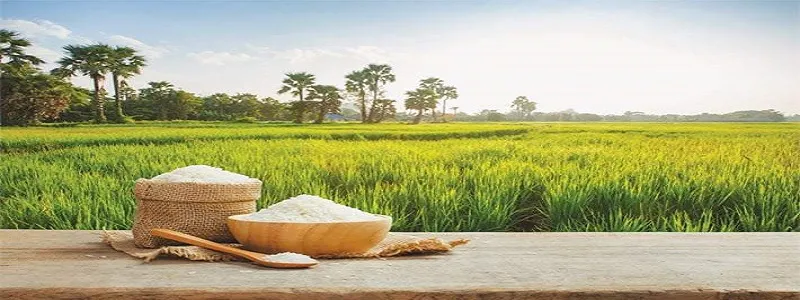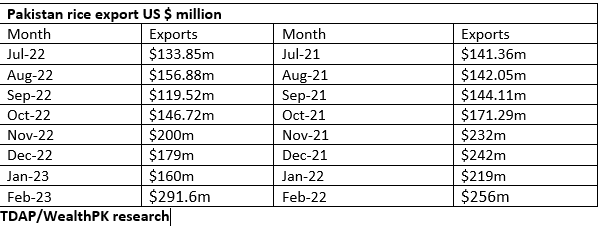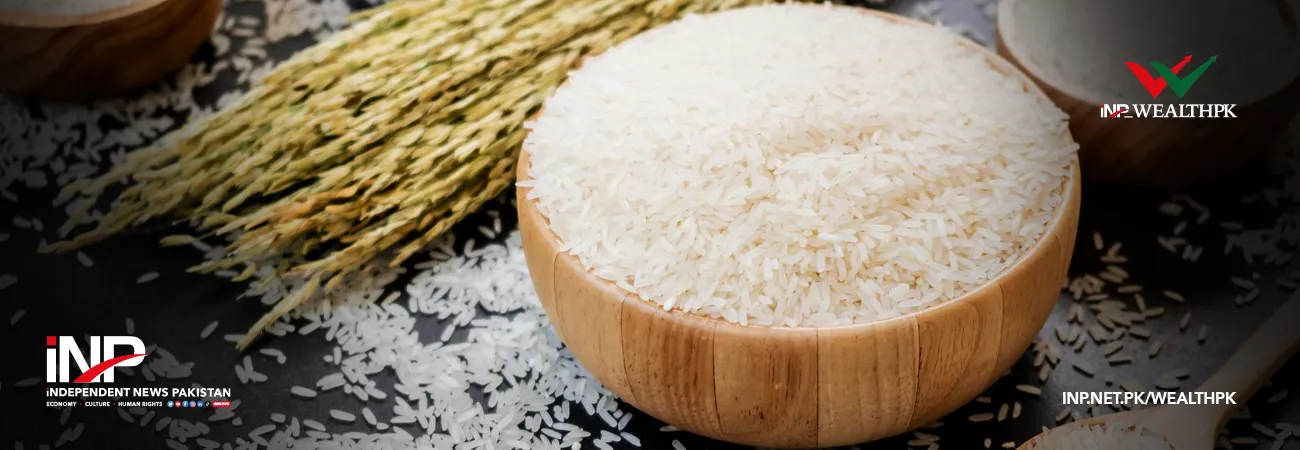INP-WealthPk
Arsalan Ali
Pakistan’s rice exports witnessed a significant upswing during February 2023 after a five-month decline, according to the Trade Development Authority of Pakistan (TDAP).

The country’s rice exports stood at $291.6 million during February FY23, reflecting a growth of 14% compared to the same month last year, when exports were recorded at $256 million. Rice exports surged 82.2% during February 2023 compared to January 2023, when exports were recorded at $160 million.

According to a recent report by TDAP, Punjab province was the top contributor to the country’s rice production. The report highlighted that Punjab accounts for 63% of the total rice production, followed by Sindh province with 29% of production, Balochistan 6%, and Khyber Pakhtunkhwa 2%.
According to the TDAP report, China has emerged as the global leader in rice yield, with an average of 6.95 metric tons per hectare during the years 2015-2020. The next large producer is Vietnam, which boasts an average yield of 5.69 metric tons per hectare, while Indonesia ranks third with an average yield of 5.15 metric tons per hectare.
Despite being the world’s largest producer of rice, India falls behind its Asian counterparts with an average yield of 3.85 metric tons per hectare. Pakistan, on the other hand, occupies the sixth spot on the list, with an average yield of 3.14 metric tons per hectare.
The report maintained that Pakistan’s rice yield has been on a downward trend since 2017. In 2015, the country’s average yield stood at 3.7 metric tons per hectare, followed by a subsequent increase in 2016 and 2017. The yield peaked at 3.85 metric tons per hectare in 2017, after which it steadily declined to its current average of 2.52 metric tons per hectare.
Despite changing technological landscape and increasing adoption of modern techniques in the agriculture sector, Pakistan continues to struggle with low rice yields. This has resulted in a loss of competitiveness for Pakistani rice in international retail markets, according to the report.
In Pakistan, basmati rice is primarily cultivated in Punjab, while non-basmati rice is grown in Sindh. The country’s top import markets for Basmati rice include United Arab Emirates, Kazakhstan, Saudi Arabia, Oman, Kenya, and Somalia. Meanwhile, the top importing markets for Pakistan’s IRRI rice are China, Malaysia, Afghanistan, Kenya, Mozambique, and Madagascar, with China serving as the largest importing market for Pakistani IRRI rice.
According to Rafiq Sulaiman, Convener of the Rice Exports Committee of the Federation Chamber of Commerce and Industry (FPCCI) and former Chairman Rice Exporters Association of Pakistan (REP), the recent flood in Sindh has had a significant impact on the rice crop. He said 40% of rice crop has been affected, resulting in an overall decrease in rice exports.
This statement comes in light of data from the TDAP, which shows that during the first eight months (July-February) of the current fiscal year, the exports of rice were recorded at $1.387 billion, indicating a decline of 10.3% compared to the same period in the previous year, which saw $1.547 billion exports.
Sulaiman further noted that the export of both Basmati and non-basmati rice have experienced a decline. Data from the Pakistan Bureau of Statistics (PBS) shows that the export of basmati rice declined by 10.56% while non-basmati rice export declined by 12.68% during the first eight months of this fiscal year.
The report highlighted the urgent need for the Pakistani government to prioritise its plans related to research and development investment in the rice sector. It emphasised the importance of tapping into developing markets such as Africa and Central Asia to diversify the country’s rice export efforts.
According to the report, countries around the world are increasing their value addition in the rice sector. Therefore, it said, Pakistan should focus its resources on exporting value-added rice products. Extensive research is needed on value-added products such as rice bran oil, rice wax, and puffed rice. To ensure the smooth functioning of the rice market and enable more informed policy decisions, the government must provide timely and accurate market information on production, consumption, exports, prices, and stocks to market participants, the report said.
Credit: Independent News Pakistan-WealthPk













